*NURSING > EXAM > NUR 1172 -Nutrition exam 3 - Test Bank (2019/20) - Rasmussen College > ALready Graded A+ (All)
NUR 1172 -Nutrition exam 3 - Test Bank (2019/20) - Rasmussen College > ALready Graded A+
Document Content and Description Below
NUR 1172 -Nutrition exam 3 Chapter 18: Drug-Nutrient Interactions Chapter 20: Gastrointestinal Diseases Chapter 21: Diseases of the Heart, Blood Vessels, and Lungs Chapter 22: Diabetes Melli... tus Chapter 23: Renal Disease Chapter 18: Drug-Nutrient Interactions 1. The age group that is at greatest risk for developing a drug-nutrient interaction is: 2. One reason why older adults may experience harmful drug-nutrient interactions is that they: 3. A type of drug that may cause stomach irritation and even gastric bleeding is: 4. A type of medication that can stimulate appetite is: 5. Use of tricyclic antidepressants and antipsychotic drugs such as amitriptyline hydrochloride (Elavil), chlorpromazine hydrochloride (Thorazine), and clozapine (Clozaril) can result in: 6. Use of anabolic steroids can result in: 7. Drugs that can depress appetite include: 8. A type of drug that may cause weight gain in clients is: 9. The term used to describe the loss of taste sensation is: 10. A drug that may help increase nutrient absorption in gastrointestinal disorders is: 11. A type of over-the-counter drug that can produce severe malabsorption is: 12. Any drug that prevents absorption of vitamin D will indirectly cause a deficiency of: 13. One way that some drugs can cause mineral depletion is through: 14. Symptoms such as weakness, nausea, anorexia, vomiting, and apprehension indicate a deficiency of: 15. Potassium deficiency may be caused by the use of: 16. A medication that can interfere with nutrient absorption via chelation is: 17. Iron deficiency related to chronic blood loss may be caused by the use of: 18. Natural licorice is sometimes used to heal gastric ulcers, but it has a side effect of: 19. Use of oral hypoglycemic agents in combination with alcohol may cause: 20. Calcification of soft tissue may occur from long-term use of: 21. A drug that should not be used in the latter part of pregnancy because it may cause birth defects is: 22. Aspirin may have beneficial effects for patients with: 23. Research has shown that the beneficial effects of aspirin are the result of inhibition of: 24. Drugs such as the antimalaria drug pyrimethamine inhibit the action of: 25. The chemotherapeutic agent methotrexate has multiple antagonistic effects on: 26. A medication that adversely affects folic acid metabolism is: 27. The anticoagulant warfarin (Coumadin) acts as an antagonist to: 28. A diuretic that may cause high blood potassium levels is: 29. The class of medications associated with tyramine syndrome is: 30. A severe tyramine reaction may cause a crisis due to: 31. Abuse of alcohol can lead to low levels of: 32. Hypoglycemic drugs prescribed to control type 2 diabetes may precipitate hypoglycemia by: 33. The medication used in the treatment of alcoholism that may cause nausea, vomiting, and headache when alcohol is consumed is: 34. Grapefruit juice increases the bioavailability of several drugs by: 35. Slower gastric emptying will tend to cause drug absorption to: 36. Absorption of iron is improved by eating foods that are high in: 37. A vitamin that can help overcome pulmonary oxygen toxicity is: 38. Absorption of tetracycline is hindered when ingested with: 39. A nutrient that delays gastric emptying time, thereby creating more optimal saturation rates for drug absorption is: 40. It is important to ask patients if they use herbal remedies because: 41. Vegetables such as cabbage, broccoli, and cauliflower can accelerate medication metabolism because they: 42. A cooking method that can increase hepatic drug metabolism through enzyme induction is: 43. Megadose intakes of pyridoxine or folate reduce the effectiveness of some: 44. An example of a cruciferous vegetable is: 45. The action of liver enzymes that metabolize drugs is influenced by relative dietary quantities of: 46. Responsibility for monitoring drug-food-nutrient interactions is assumed by: 47. The goal of coordinating food service, pharmacy, and clinical nutrition in hospital settings is to: 48. A meal that may be inappropriate for a patient taking warfarin (Coumadin) is: Chapter 20: Gastrointestinal Diseases 1. When mouth tissues become inflamed, initial nutritional recommendations include: 2. The medical term for difficulty in swallowing is: 3. For a client who has achalasia, the diet of choice is: 4. The term pyrosis means: 5. A good meal for someone with xerostomia would be: 6. The patient most likely to develop a hiatal hernia is: 7. Malignancy is a common development in patients with: 8. Peptic ulcers occur most frequently in the: 9. Peptic ulcer disease may be caused by: 10. A characteristic symptom of a peptic ulcer is: 11. A basic principle guiding nutritional management of peptic ulcer disease is to eat: 12. People who have peptic ulcer disease are encouraged to avoid drinking: 13. Diagnosis of celiac disease is confirmed using: 14. Grains that should be eliminated from the diets of clients on a restricted gluten diet include: 15. Cystic fibrosis is a disease that primarily affects the: 16. Level I routine care of patients with cystic fibrosis includes: 17. The chronic inflammatory bowel disease that involves all layers of the intestinal wall is known as: 18. Inflammatory bowel disease that is confined to the colon and rectum is known as: 19. During an acute exacerbation of inflammatory bowel disease, if the patient can tolerate an oral diet, the diet should be: 20. During remission, patients with Crohn’s disease are encouraged to increase their intake of: 21. Patients with short-bowel syndrome usually need parenteral nutrition support only until: 22. The small outpouchings that protrude from the intestinal lumen are called: 23. If diverticula of the large intestine become inflamed, the condition is called: 24. The type of diet prescribed for long-term management of diverticular disease is: 25. Dietary changes that help reduce the incidence of constipation include: 26. An appropriate meal for someone with celiac disease would be: 27. Patients with cystic fibrosis need extra: 28. A major clinical symptom associated with hepatitis is: 29. Medical treatment of hepatitis includes: 30. Adequate dietary protein is essential for recovery from hepatitis because protein: 31. The amount of protein that should be consumed by a client who has viral hepatitis is: 32. In patients with viral hepatitis, the major barrier to adequate nutritional intake is: 33. Pathologic changes in the liver caused by cirrhosis include: 34. The earliest clinical manifestations of cirrhosis include: 35. Development of ascites in clients who have cirrhosis is related to: 36. One effect of impaired blood circulation through the liver caused by fibrous tissue is the development of: 37. Nutrition support for the client who has cirrhosis includes a: 38. A key component in the etiology of hepatic encephalopathy is: 39. Clinical signs of hepatic encephalopathy include: 40. The primary objective of treatment of hepatic encephalopathy is to: 41. The recommended plan of nutrition therapy for clients who have hepatic encephalopathy is a: 42. Drugs used to control blood ammonia levels in patients with hepatic encephalopathy are: 43. The gallbladder is stimulated to contract and release bile by: 44. Inflammation of the gallbladder is called: 45. The presence of gallstones in the gallbladder is called: 46. Gallstone formation is promoted by: 47. A characteristic clinical symptom of gallbladder inflammation or gallstones is: 48. Nonsurgical treatment for gallstones may include: 49. Nutrition therapy for clients who have gallbladder disorders focuses on: 50. Factors responsible for development of acute pancreatitis include: 51. The initial diet prescription for clients who have acute pancreatitis is: Chapter 21: Diseases of the Heart, Blood Vessels, and Lungs 1. Development of coronary heart disease is related to: 2. In the process of atherosclerosis: 3. The layer of the artery in which atherosclerotic plaque forms is the: 4. Plaque usually consists mainly of: 5. Several types of blood lipoproteins are synthesized in the: 6. The function of lipoproteins in body metabolism is to transport: 7. The class of lipoproteins that has the highest lipid content is: 8. The classes of lipoproteins that carry the most triglyceride by weight are: 9. The class of lipoproteins that is most responsible for atherosclerosis and is considered “bad cholesterol” is: 10. The type of lipoprotein that is considered to be protective against cardiovascular disease is: 11. The protein component that attaches itself to lipoproteins and has a significant effect on function is: 12. In nutritional management of high serum cholesterol levels, TLC stands for: 13. In patients with elevated serum LDL cholesterol levels, monounsaturated fat intake should be: 14. Foods high in monounsaturated fats include: 15. According to TLC recommendations, a type of fatty acid that should be avoided as much as possible is: 16. Fats high in polyunsaturated fats include: 17. A desirable blood cholesterol level is: 18. The major principle that guides nutrition planning for clients who have coronary heart disease is: 19. Good sources of soluble dietary fiber include: 20. Soluble fibers are believed to be beneficial for preventing heart disease because they: 21. Therapeutic dietary options for enhancing lowering of LDL cholesterol include: 22. Drug therapy should be considered for patients with hypercholesterolemia when: 23. When blood supply to a tissue or body part is reduced, the result is referred to as: 24. A localized area of dead tissue is called a(n): 25. If a patient who has just had a myocardial infarction has hypertension, his or her recommended diet would be: 26. Congestive heart failure can lead to an imbalance in: 27. The stimulus for the renin-angiotensin-aldosterone mechanism is: 28. Congestive heart failure affects the renin-angiotensin-aldosterone mechanism so that: 29. Nutrition therapy for clients who have congestive heart failure focuses on restriction of dietary intake of: 30. The renin-angiotensin-aldosterone mechanism tends to promote the retention of sodium and the excretion of: 31. The cause of essential hypertension is: 32. An important feature of the Dietary Approaches to Stop Hypertension (DASH) eating plan is: 33. The upper limit of normal blood pressure in adults is considered to be: 34. The three types of body systems that maintain normal blood pressure are: 35. In the United States, the incidence of stroke is highest among: 36. The diagnosis of prehypertension, stage 1 hypertension, or stage 2 hypertension is based on: 37. Medical nutrition therapy for treatment of hypertension includes: 38. The main source of dietary sodium is: 39. Most strokes are caused by: 40. Chronic obstructive pulmonary disease (COPD) is often accompanied by: 41. The factor that guides nutrition therapy for clients with COPD is the: 42. Patients who have experienced stroke may need to eat softened foods and thickened liquids if they have: 43. Clients with COPD should have intakes that are higher than is normally recommended for: 44. The most important factor that contributes to development of peripheral vascular disease is: 45. The amount of fluid recommended for clients with pneumonia (who do not need fluid restrictions) is: 46. The objective of nutritional management for clients with tuberculosis is to: 47. Elevated blood levels of C-reactive protein indicate: 48. An example of a meal high in soluble fiber is: 49. Omega-3 fatty acids help decrease risk of heart disease by: 50. The food that would be lowest in sodium is: Chapter 22: Diabetes Mellitus 1. People with type 1 diabetes have a problem with the function of cells in their: 2. The underlying cause of type 1 diabetes is: 3. An example of a health factor associated with insulin resistance is: 4. A population group that has a genetic susceptibility to type 2 diabetes is: 5. Metabolic syndrome includes: 6. In people with type 1 diabetes, insulin production is: 7. Type 1 diabetes is characterized by: 8. Type 2 diabetes: 9. Initial client symptoms of type 1 diabetes include polydipsia, polyuria, and: 10. Clinical laboratory results found in uncontrolled type 1 diabetes include: 11. The term that refers to an elevated blood glucose level is: 12. The pathophysiology of diabetes has most effect on the metabolism of: 13. The normal range for blood glucose is: 14. Sources of blood glucose include dietary carbohydrates, fats, proteins, and: 15. The function of the beta cell portion of the pancreatic islets cells is to synthesize: 16. The delta cells of the pancreas synthesize: 17. The alpha cells of the pancreas synthesize: 18. The pancreatic sensors of blood glucose levels are located in the: 19. One of the major functions of insulin is to: 20. The hormone that is considered to be an antagonist to insulin is: 21. The hormone that regulates blood glucose level by inhibiting interactions of insulin and glucagon is: 22. The nutrient that produces ketones as a by-product of metabolism is: 23. A common symptom among people with undiagnosed type 2 diabetes is: 24. Common complications of diabetes affect the: 25. A standard blood test that is used to evaluate long-term management and control in clients who have diabetes is: 26. Basic objectives in the care of the person who has diabetes include maintaining normal blood glucose levels, preventing complications, and: 27. People who have diabetes are at particular risk for: 28. Development of complications of type 1 diabetes can be minimized by: 29. The dose of insulin required for a meal is usually about 1 unit of insulin per: 30. The effects of glucagon include: 31. Insulin may be used by clients with type 2 diabetes if they: 32. One way that people with impaired glucose tolerance can prevent development of type 2 diabetes is to: 33. Insulin is a(n): 34. Type 2 diabetes in children and adolescents is related to: 35. One of the most common tools used for meal planning for clients with type 1 diabetes, based on the primary nutrient affecting postprandial blood glucose levels and insulin requirements, is: 36. In order to prevent ketosis, women with gestational diabetes mellitus (GDM) should consume at least: 37. The type of insulin that has its peak activity 11 hours after administration and acts for approximately 20 to 29 hours is: 38. Clients with type 1 diabetes can achieve more consistent blood glucose control using: 39. A self-management technique that guides insulin prescriptions for clients with type 1 diabetes is: 40. Development of type 2 diabetes is closely linked to: 41. Historically, type 2 diabetes is typically diagnosed after age: 42. A major focus of the dietary prescription for people who have type 2 diabetes is to: 43. One way in which oral hypoglycemic drugs act to lower elevated blood glucose levels is by: 44. Nutrition therapy for diabetes is based on: 45. A client with diabetes would need to adjust or modify his or her diet if he or she is: 46. For a client with GDM, an acceptable blood glucose level 2 hours after a meal would be: 47. Infants born to mothers with GDM may experience: 48. Infants born to mothers with GDM may have macrosomia because: 49. If someone with type 1 diabetes starts drinking alcoholic beverages an hour before a meal, they are likely to experience: Chapter 23: Renal Disease 1. The basic functional units of the kidney are called: 2. The laboratory test result that is generally used to predict glomerular filtration rate (GFR) in clinical practice is: 3. The kidney structure that is responsible for filtering the blood is the: 4. The main function of the proximal tubule of the glomerulus is: 5. The main function of the loop of Henle is: 6. The main function of the distal tubule of the nephron is: 7. Normal nephron function is adversely affected by: 8. The most common causes of end-stage renal disease are: 9. In patients without diabetes, chronic kidney disease (CKD) is most commonly caused by: 10. Normal GFR is: 11. A client with GFR of 15 mL/min/1.73 m2 has: 12. Significant comorbidities in patients with CKD include: 13. Patients with CKD who have excessive sodium intakes may experience: 14. Patients with renal disease usually have a chronic state of inflammation, as shown by elevated serum levels of: 15. The presence of protein in the urine is called: 16. The term oliguria refers to: 17. The term hematuria refers to: 18. Factors that contribute to malnutrition in patients with chronic renal failure include: 19. Electrolyte imbalances that occur in chronic renal failure include: 20. In patients with CKD, sodium intake does not usually need to be restricted until GFR falls to: 21. The bone disease osteodystrophy often occurs in patients with: 22. Osteodystrophy develops because of the kidney’s inability to: 23. Patients with chronic renal insufficiency develop anemia because their kidneys synthesize inadequate amounts of: 24. Potassium intake is restricted if serum potassium level is higher than: 25. The recommended protein intake for a 35-year-old man with a GFR of 20 mL/min/1.73 m2 who weighs 80 kg is: 26. In young adults with chronic renal disease, daily energy intake should be: 27. Dietary carbohydrates and fats are important for clients with chronic renal failure because they: 28. The recommended fluid intake for a 60-year-old woman with stage 5 CKD treated with hemodialysis who weighs 60 kg and has a urine output of 300 mL/day is: 29. In a 45-year-old man with CKD who weighs 90 kg and is treated using hemodialysis, protein intake should be: 30. The method of dialysis that gives clients the greatest amount of freedom of mobility is: 31. One of the basic objectives of medical nutrition therapy for clients receiving dialysis is to: 32. A problem that can occur with continual ambulatory peritoneal dialysis is: 33. A treatment approach that can be used to replace dialysis for clients who have chronic renal failure is: 34. Sudden shutdown of renal function following traumatic or metabolic injury is called: 35. The major clinical symptom of acute renal failure is: 36. Factors that affect nutrition requirements in patients with acute renal failure include: 37. An increase in the serum urea nitrogen and creatinine of a client who has acute renal failure is a result of: a. tissue breakdown of muscle mass. 38. In acute renal failure (if the client is not catabolic and not receiving hemodialysis), protein intake should be about: 39. The most common component of kidney stones is: 40. The recommended diet for a person with calcium stones is relatively low in: 41. The second most common type of kidney stone is composed of: 42. The main cause of cystine stones is: 43. A key component in the management of clients who have kidney stones is to: 44. The most common symptom associated with kidney stones is: 45. A dietary component that may help protect against CKD is: 46. The factor responsible for development of most urinary tract infections is: 47. Regular consumption of cranberry juice may help: 48. Predisposing factors for renal stone formation include: [Show More]
Last updated: 1 year ago
Preview 1 out of 12 pages

Reviews( 0 )
Document information
Connected school, study & course
About the document
Uploaded On
Nov 06, 2019
Number of pages
12
Written in
Additional information
This document has been written for:
Uploaded
Nov 06, 2019
Downloads
0
Views
50


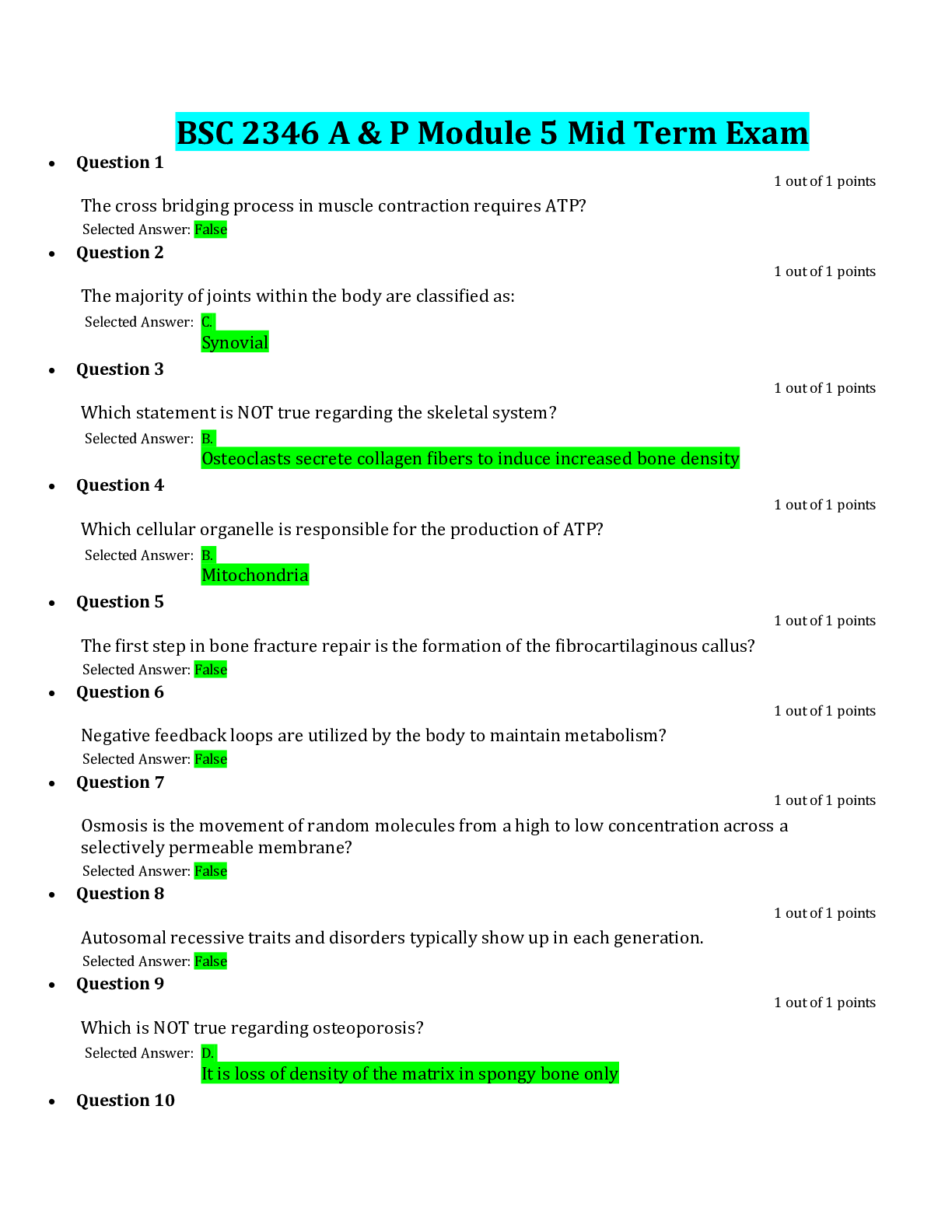
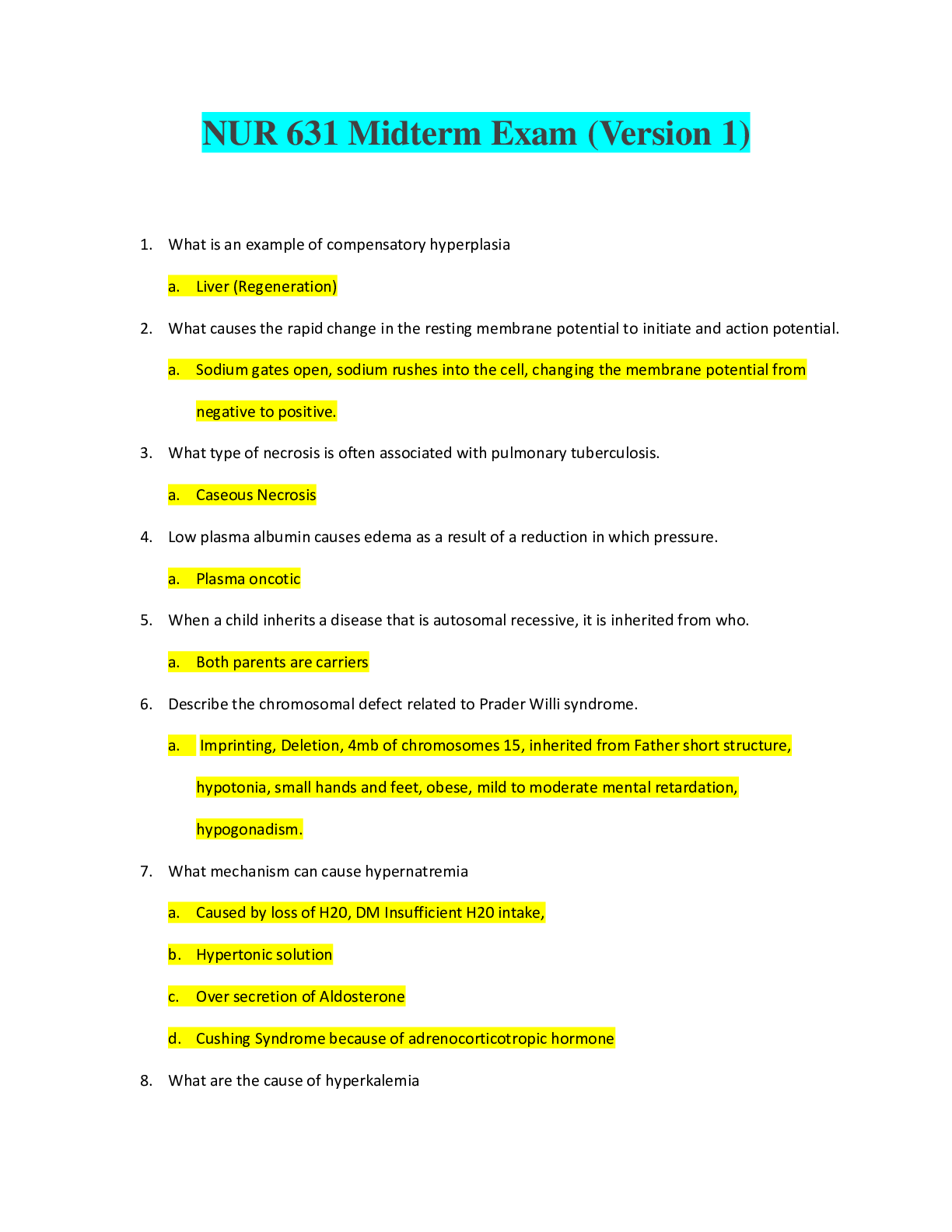


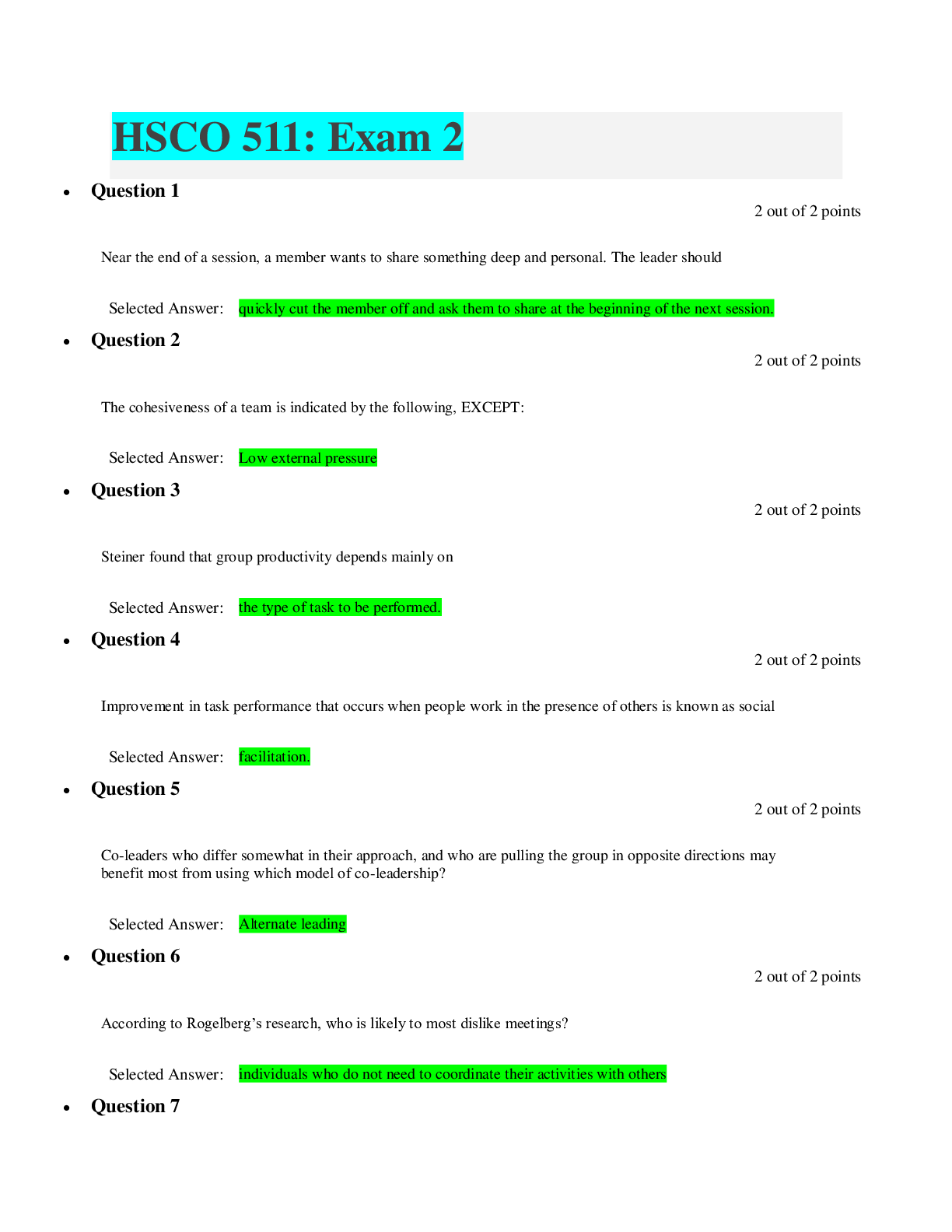
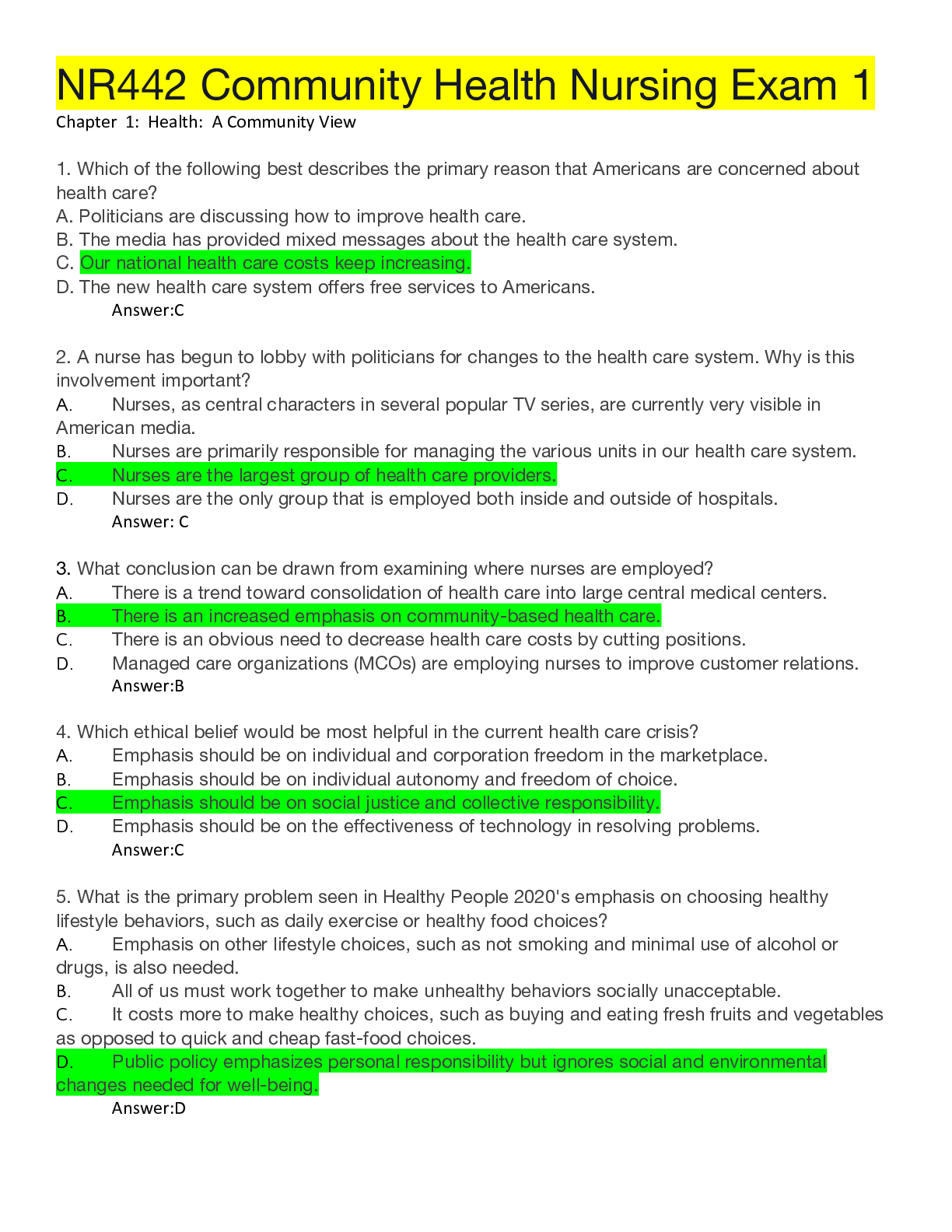
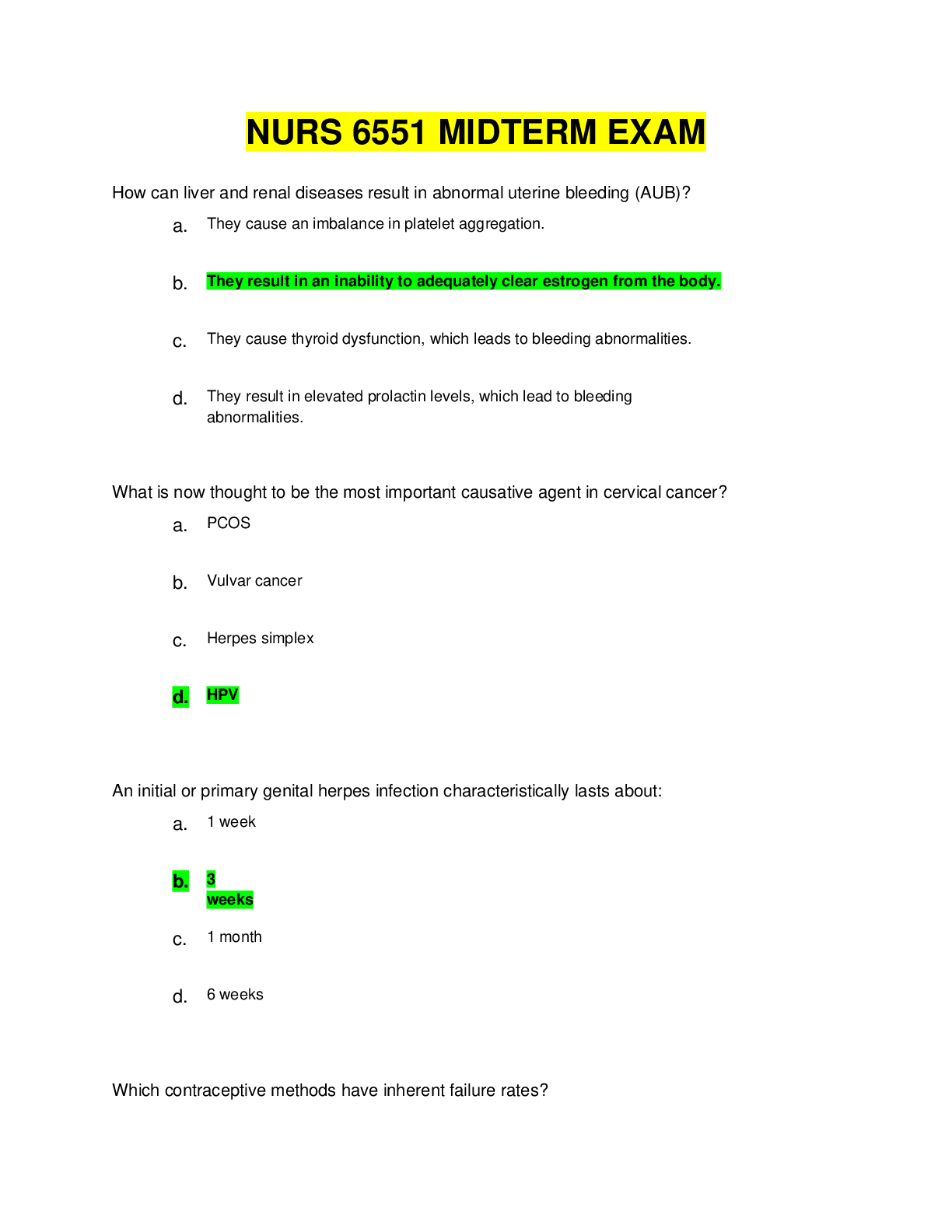
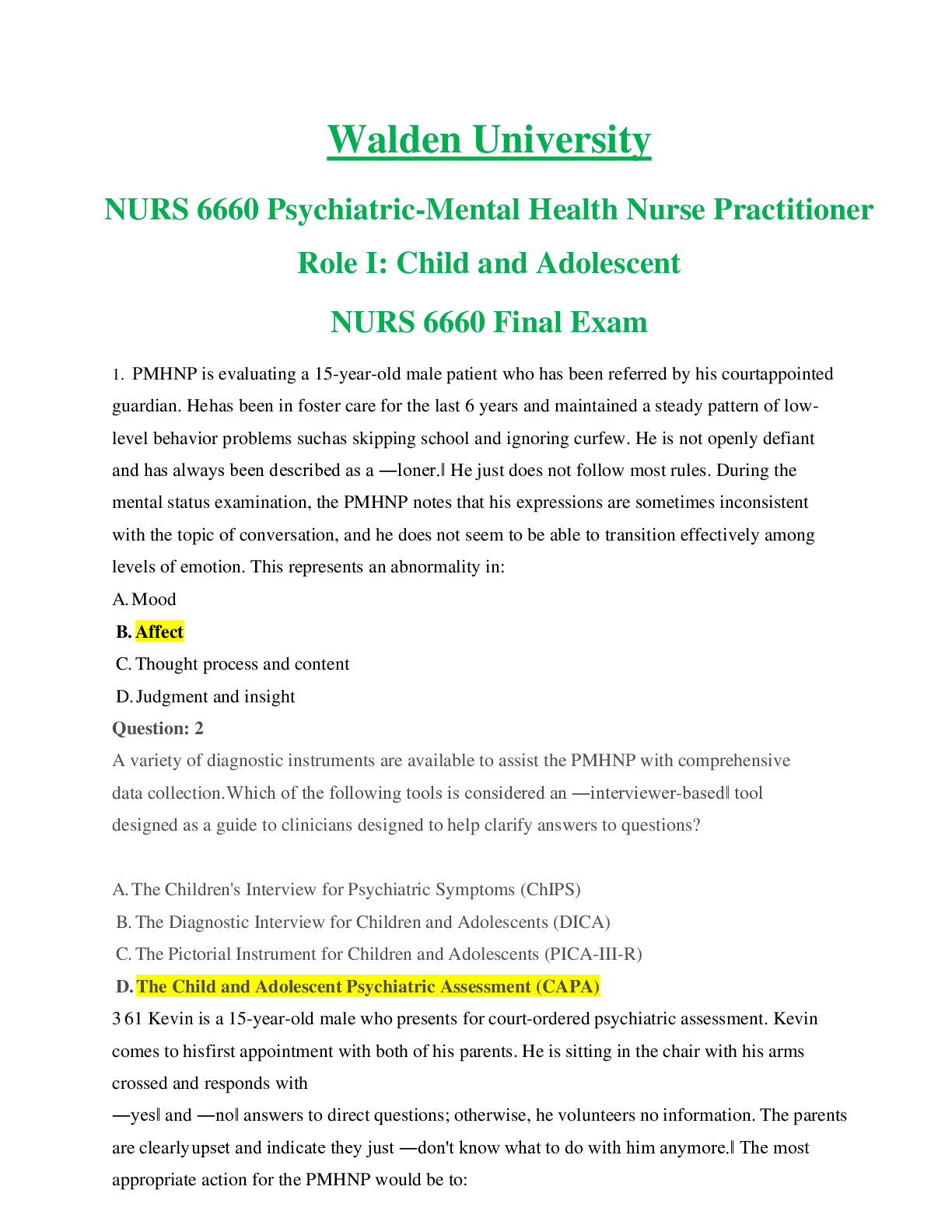


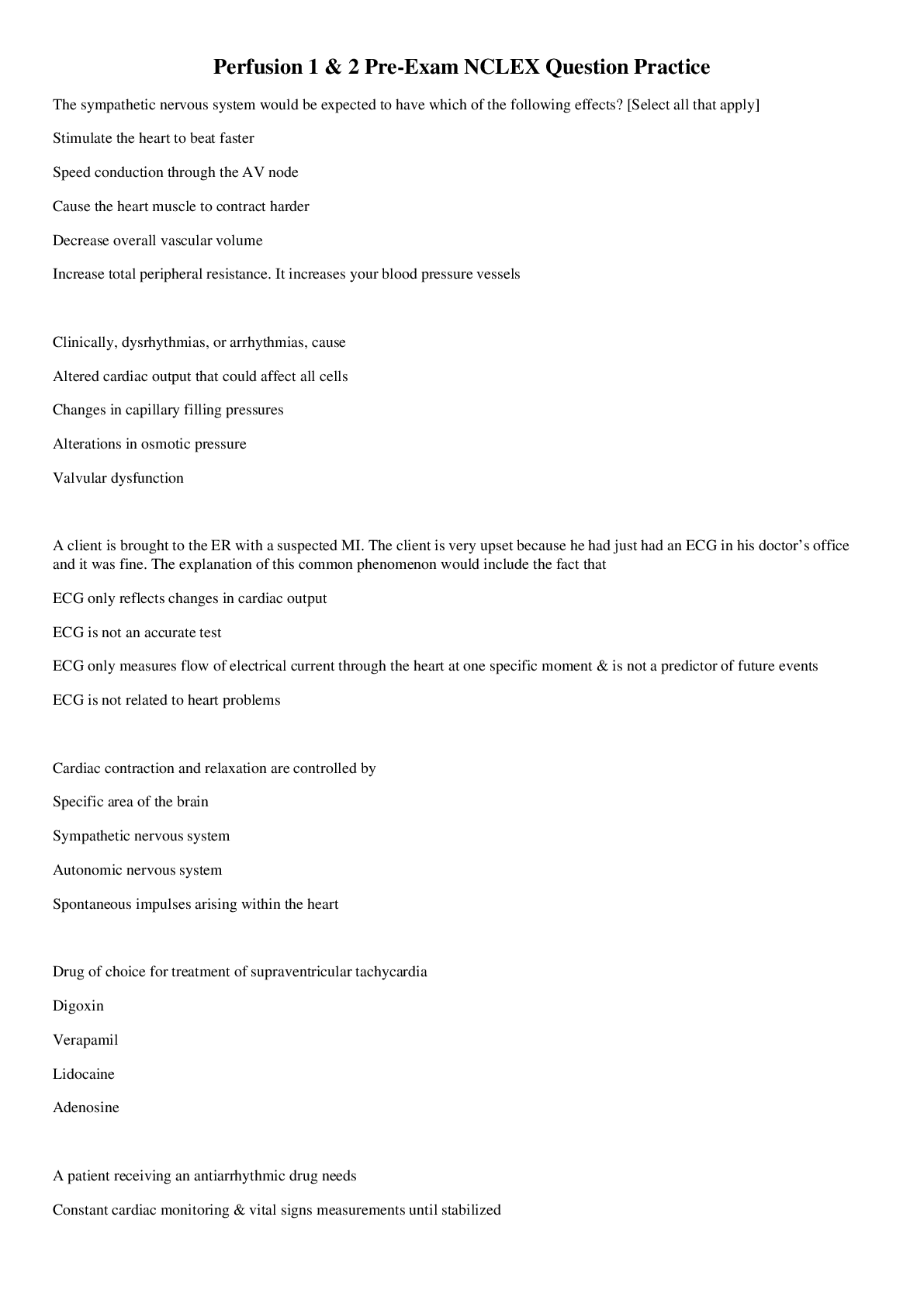
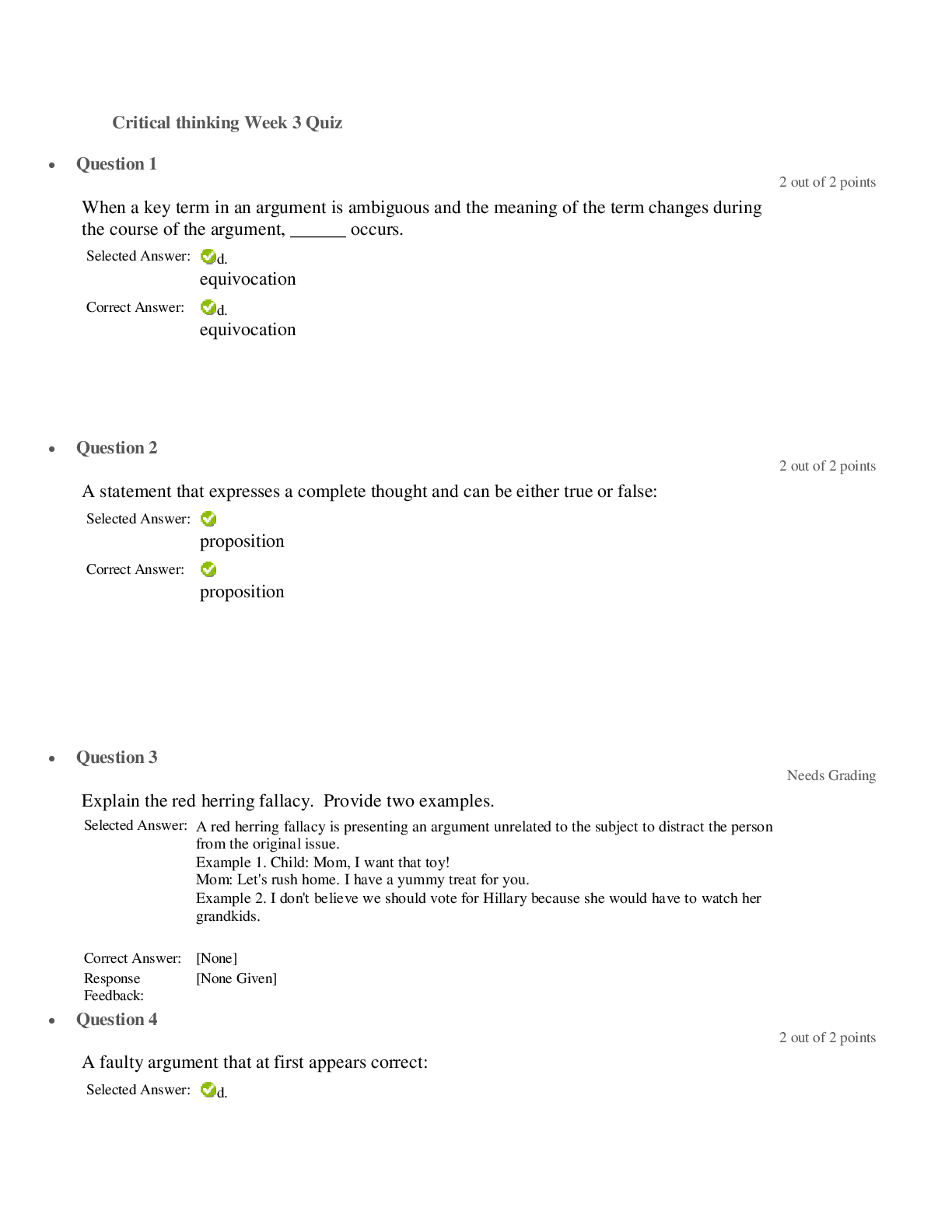


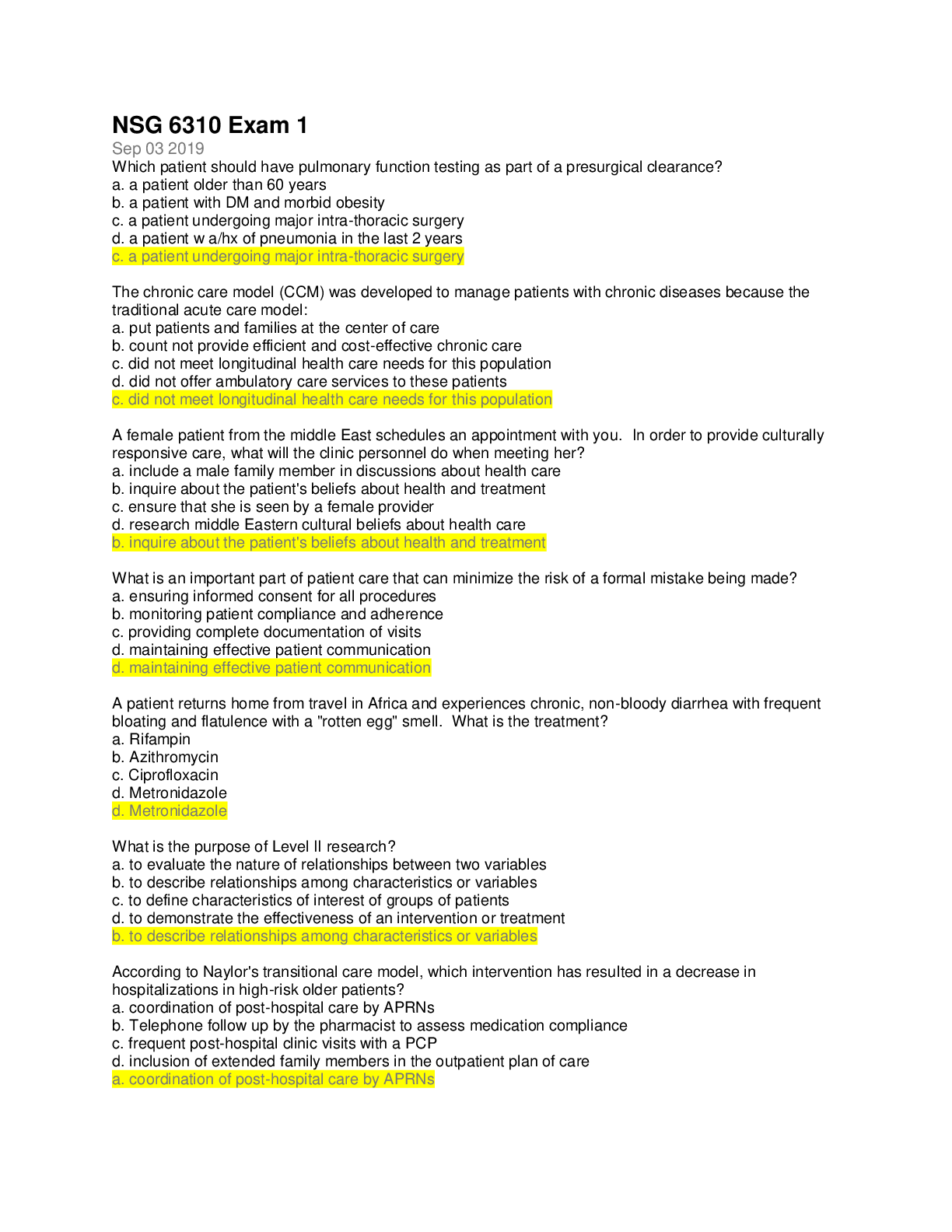
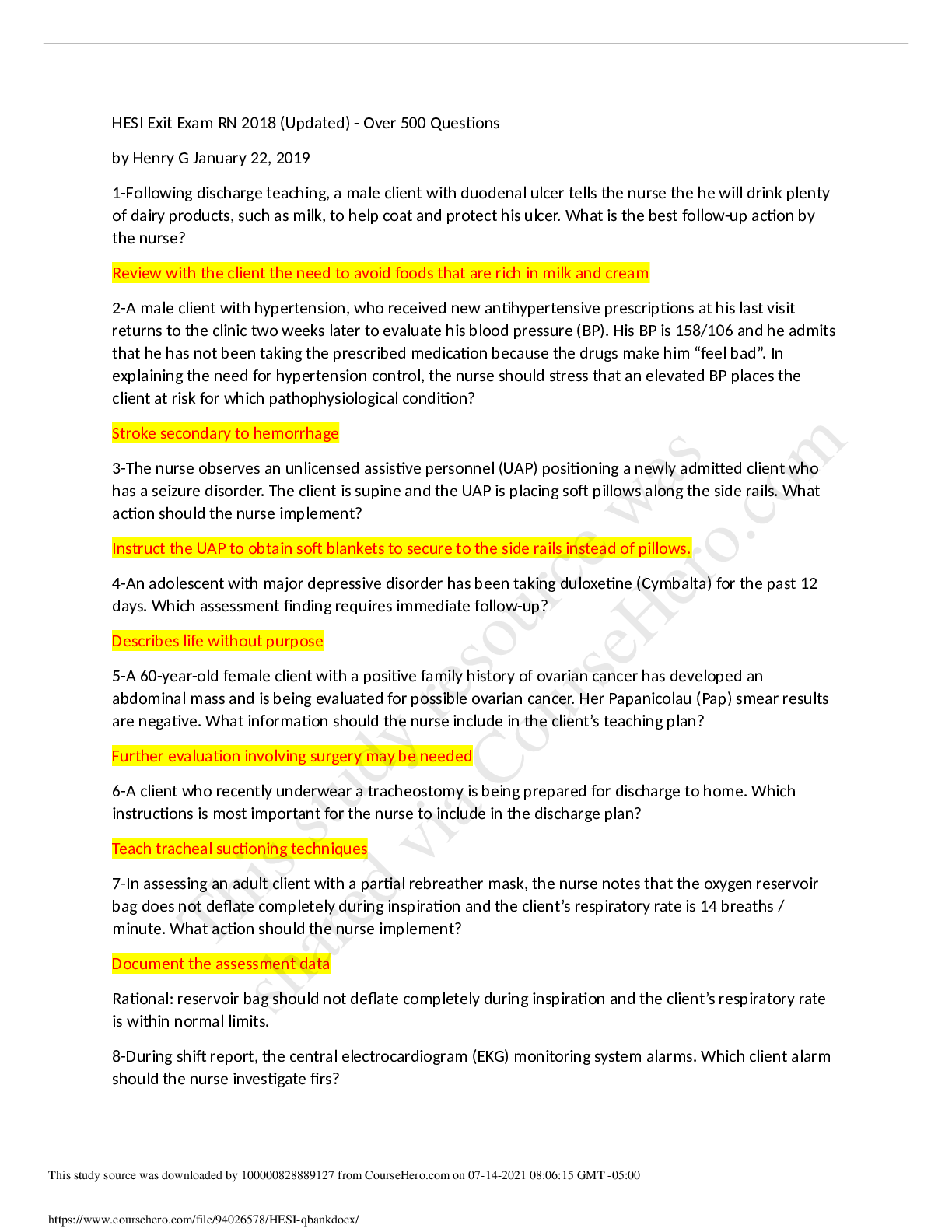
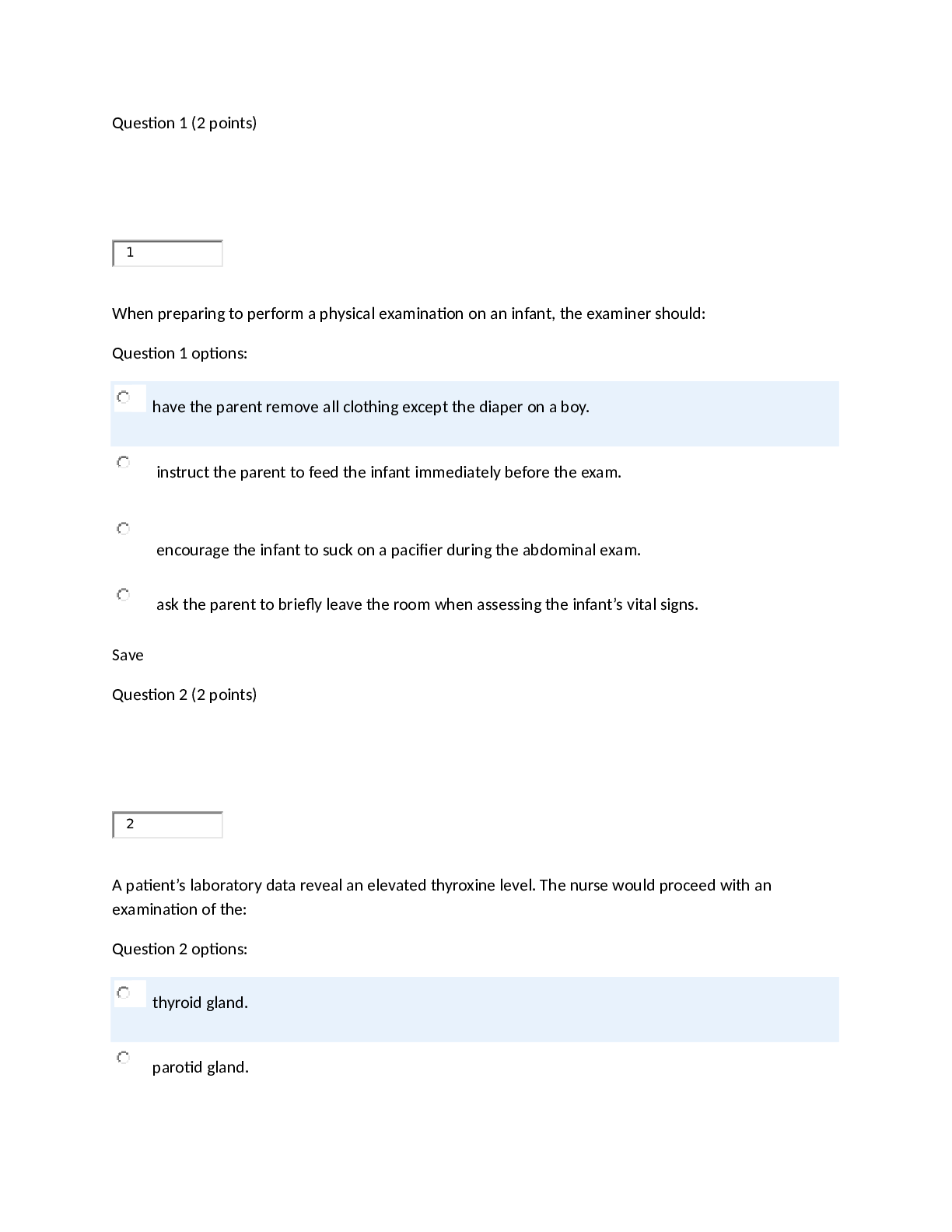
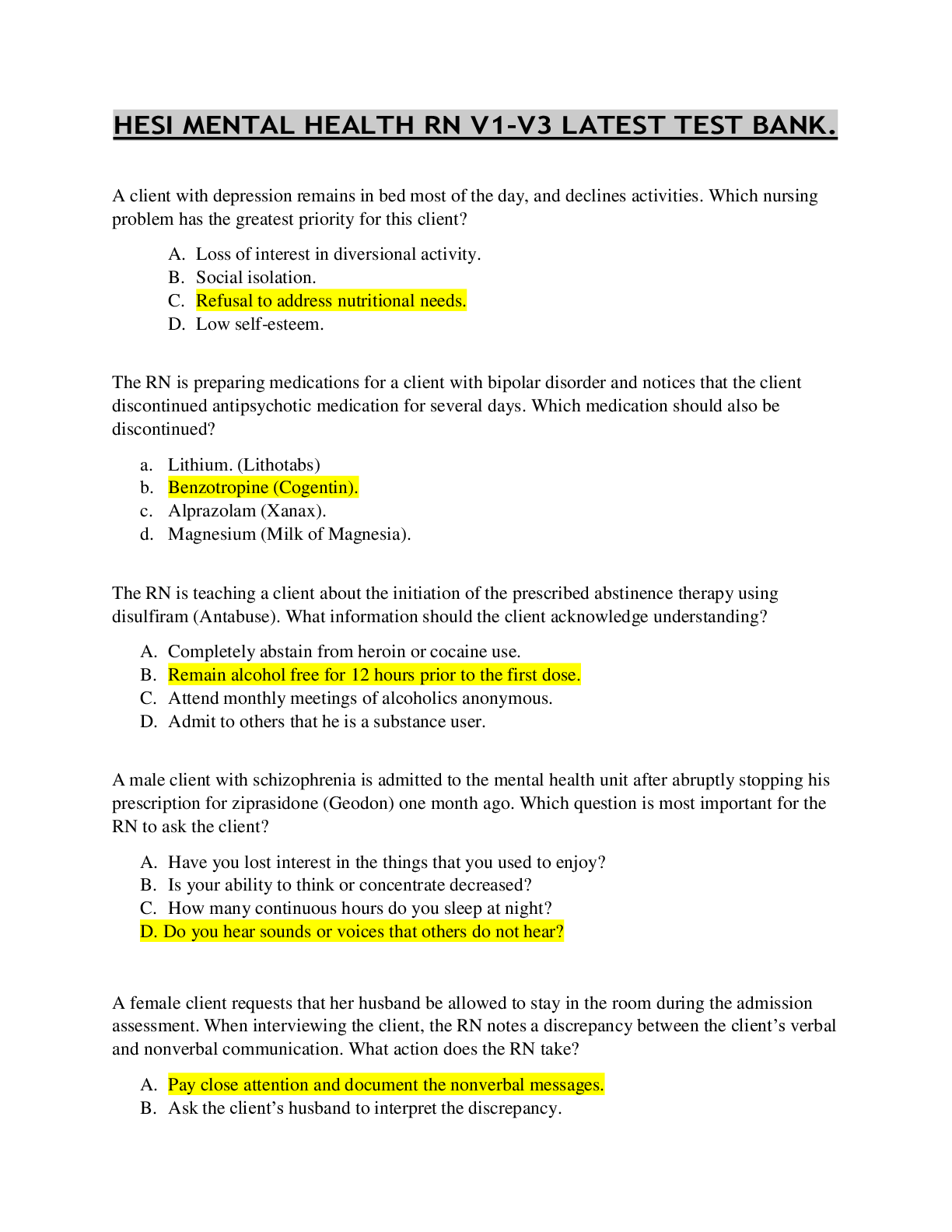
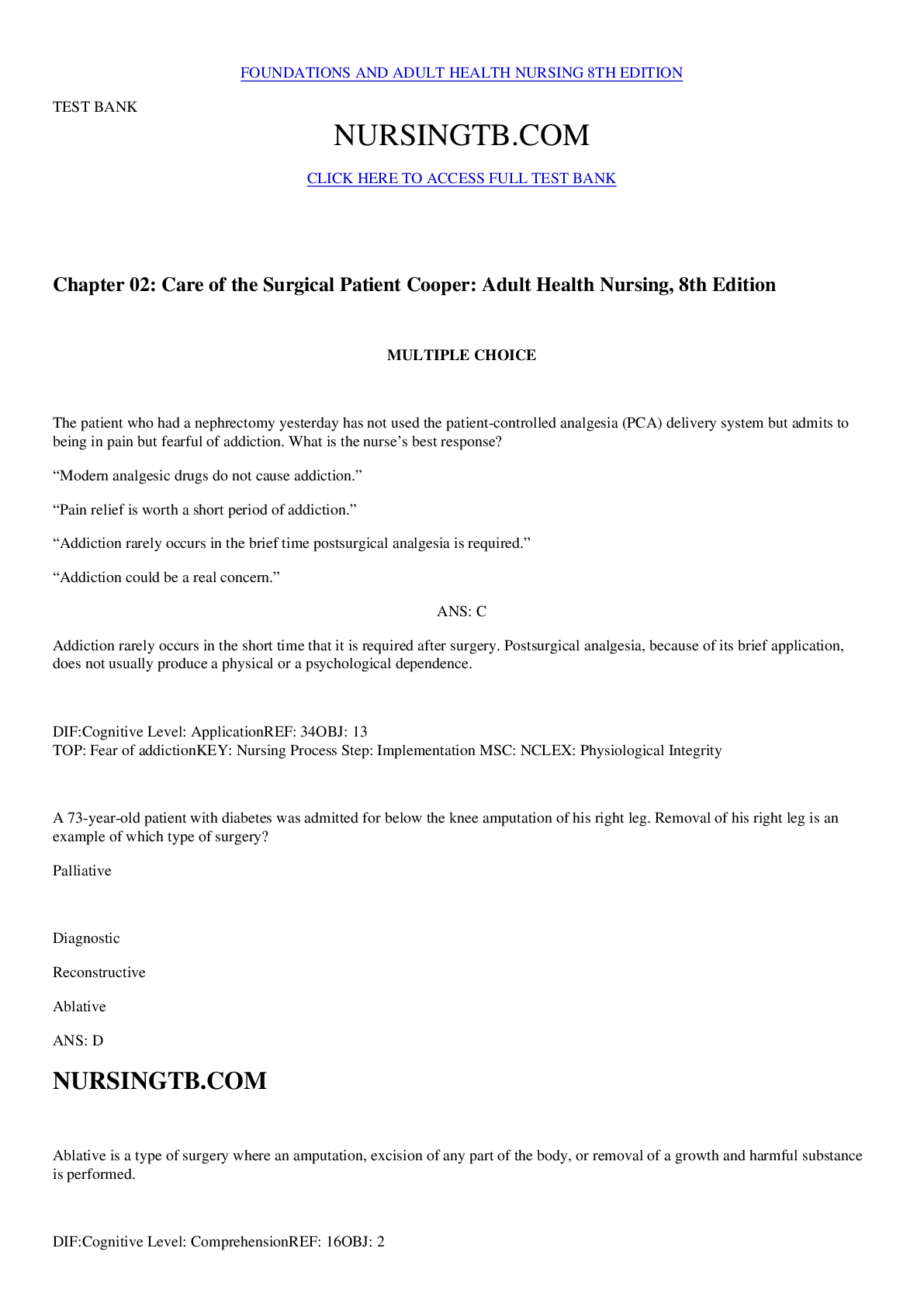
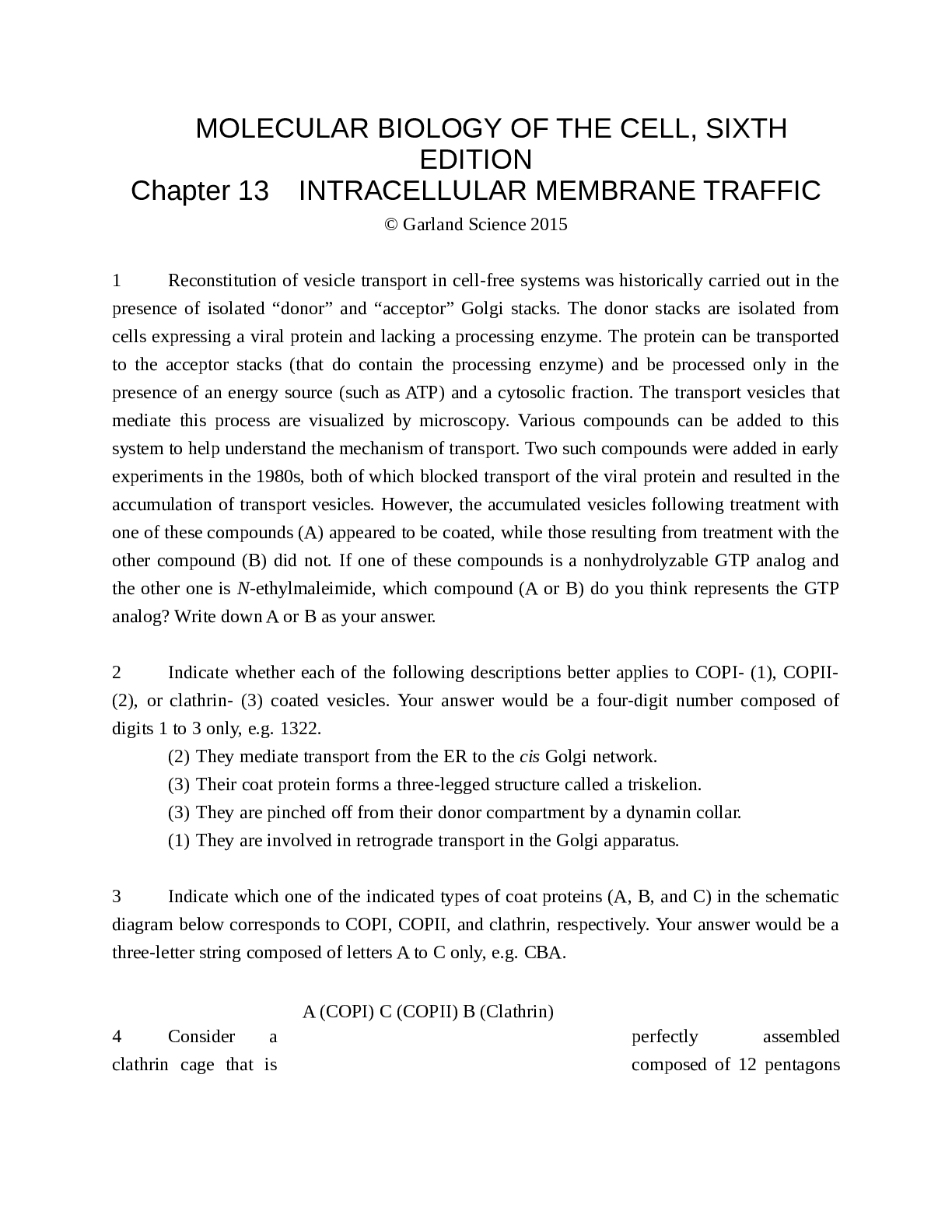
.png)
 (1).png)
.png)
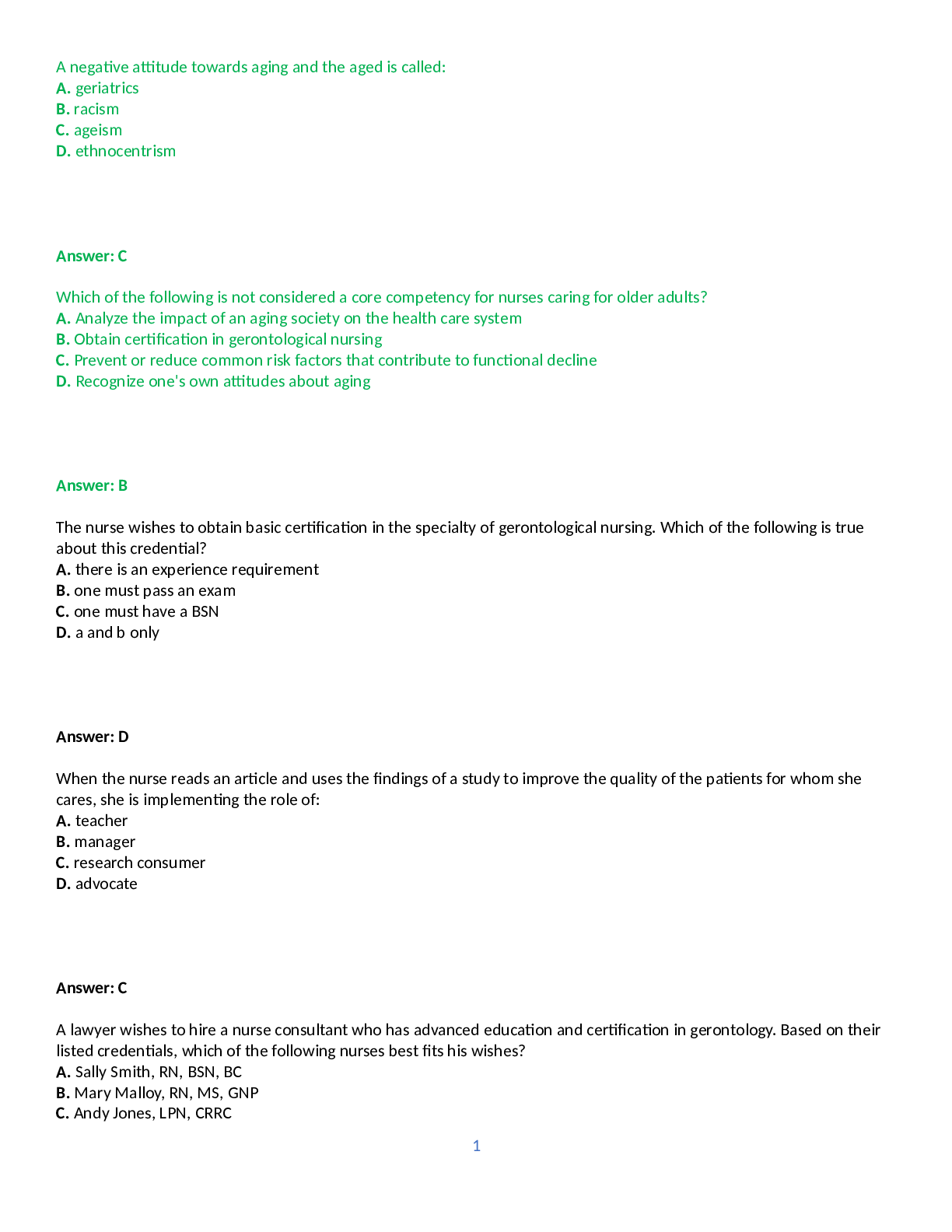
.png)

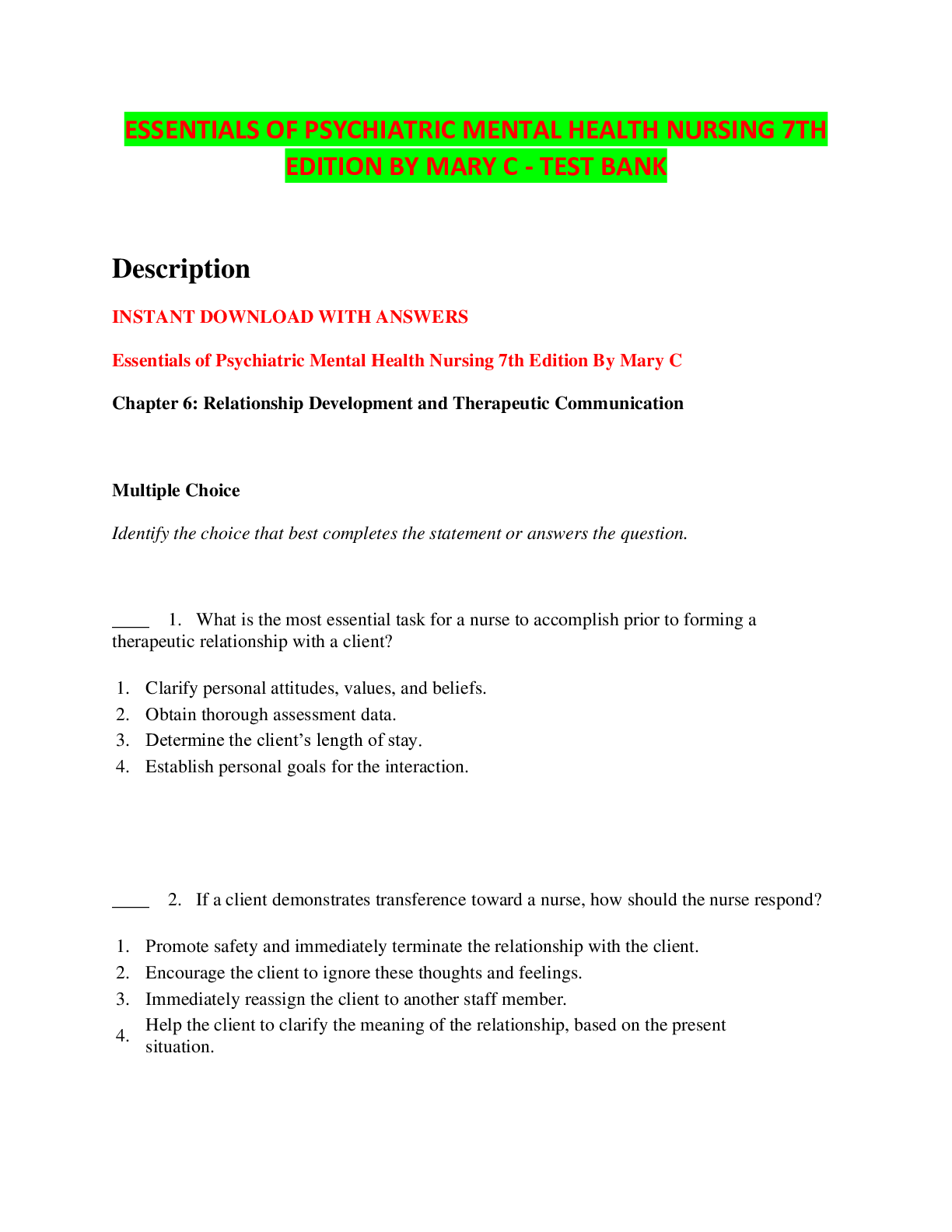

.png)


